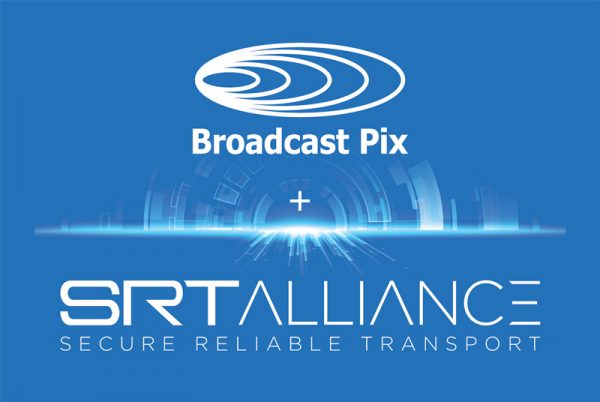 Tyngsboro, Mass. – Mar. 24, 2022 – Broadcast Pix™ today announced they have joined the SRT Alliance, a collaborative community of industry leaders and developers striving to achieve lower-latency internet video transport. The company is also adding the native support of Secure Reliable Transport (SRT) source streaming to its line of Integrated Production Systems.
Tyngsboro, Mass. – Mar. 24, 2022 – Broadcast Pix™ today announced they have joined the SRT Alliance, a collaborative community of industry leaders and developers striving to achieve lower-latency internet video transport. The company is also adding the native support of Secure Reliable Transport (SRT) source streaming to its line of Integrated Production Systems.
With remote productions now regularly incorporating global feeds in varying formats from different networks, the SRT open-source video transport protocol plays a key role in optimizing video streaming performance across unpredictable networks. Originally developed by Haivision to secure streams and simplify firewall traversal, SRT delivers the best quality video streaming combined with end-to-end encryption and low-latency processing, even over demanding networks.
The SRT Alliance, founded by Haivision in April 2017, already has more than 500 members. Its mission is to overcome the challenges of low-latency live streaming by supporting the collaborative development of the SRT protocol.
The Broadcast Pix Network Inputs now feature SRT support for the guaranteed performance of low-latency video transport. This addition expands upon the native support of most Broadcast Pix systems for a variety of streaming protocols including NDI, HTTP, RTSP, RTMP, Castus Stream and GuestPix – without requiring conversion or additional servers. From RTSP streams to robotic PTZ cameras to remote participants using GuestPix or SRT streams from an encoder, Broadcast Pix is the choice for integrating and mixing sources.
Broadcast Pix customers can also automate the selection of different sources with macros. With a click of a button or scheduled through Macro Times, Network Inputs can be dynamically switched to automatically receive remote feeds.
“We are proud to offer our users an easier approach to creating and streaming great live video,” said Broadcast Pix CEO, Graham Sharp. “By joining the SRT Alliance, we can now also help them optimize their live streaming performances through SRT. We are also excited to join the SRT Alliance and its collaborative community of industry leaders looking to make the video streaming experience better for everyone.”
 “Cloud workflows have never been more critical than they are today,” said Peter Maag, Chief Strategy Officer and EVP of Strategic Partnerships, Haivision. “With Broadcast Pix solutions adding native support for SRT, users are now able to ingest low-latency SRT streams from Haivision Makito X4 video encoders, no matter where they’re located Leading platforms like Broadcast Pix adopting SRT and joining the SRT Alliance will continue to drive the protocol forward as an important enabler for remote production workflows.”
“Cloud workflows have never been more critical than they are today,” said Peter Maag, Chief Strategy Officer and EVP of Strategic Partnerships, Haivision. “With Broadcast Pix solutions adding native support for SRT, users are now able to ingest low-latency SRT streams from Haivision Makito X4 video encoders, no matter where they’re located Leading platforms like Broadcast Pix adopting SRT and joining the SRT Alliance will continue to drive the protocol forward as an important enabler for remote production workflows.”
SRT streaming is now available on Broadcast Pix’s ChurchPix, FX, MX Hybrid, RadioPix and StreamingPix video production systems.
About Broadcast Pix
Founded in 2002, Broadcast Pix™ offers the complete toolset required to make great programs, elegantly integrated and easy to use. Our integrated production solutions feature patented control and automation technologies, plus the BPNet ecosystem that provides cost effective, secure cloud services for backup, control, and collaboration. Broadcast Pix is proud to have more than 5,000 government, broadcast, live event, and visual radio customers in more than 100 countries.
Broadcast Pix, BPswitch, Commander, ChurchPix, RadioPix and StreamingPix are trademarks of Broadcast Pix, Inc. NDI is a registered trademark of Newtek, Inc.
About the SRT Alliance
The SRT Alliance is a collaborative community of industry leaders and developers striving to achieve lower latency internet video transport by continuously improving SRT, an open source video transport protocol and technology stack. Originally developed and pioneered by Haivision, SRT optimizes streaming performance across unpredictable networks with secure streams and easy firewall traversal, bringing the best quality live video over the worst networks. Haivision was awarded an Emmy® for Technology and Engineering from the National Academy of Television Arts and Sciences for developing the SRT protocol. For more information about the project and how to join the SRT Alliance, visit srtalliance.org.
![Broadcast Pix, Inc. [US] Logo](https://broadcastpix.com/wp-content/uploads/2018/05/broadcastpix-inc-sticky-logo7.png)